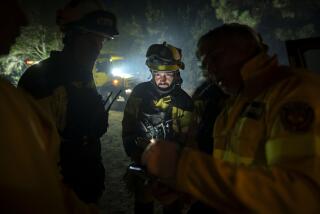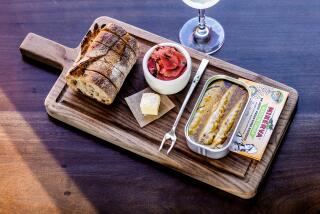Spanish Colonial Spirit Still Pervades Tenerife : Beaches and resort towns draw international visitors to the most beautiful of the Canary Islands.
- Share via
PUERTO DE LA CRUZ, Spain — Arriving on this island of eternal springtime is a little akin to receiving a lifetime lease on paradise, with an option for the hereafter.
Tenerife, the largest and most beautiful island of the Canaries and the most popular with tourists, lies about 700 miles southwest of the Spanish mainland. Ancient Egyptian and Greek writers speculated that Tenerife may be the remnant of legendary Atlantis, a lotus land of Elysian fields and ceaseless sunshine that was swallowed up by seas, leaving only the peaks of its highest mountains remaining.
When Spaniards in 1497 conquered Tenerife (pronounced ten-er-REE-fay), the last of the seven Canaries to fall, they found it inhabited by a people of equally mysterious origins. The Guanches lived in the Stone Age, dwelling in caves, wearing skins for clothing and existing by rudimentary farming, animal domestication and coastal fishing. While they were thought to be related in some way to North Africa’s Berbers, some Guanches had blond hair and fair skin, which clouded their origins even more.
Puerto de la Cruz is set in the heart of Tenerife’s verdant north-coast banana region. It’s a lush little town of flowery plazas, palm trees and old homes with intricately carved Canary-pine balconies of the 16th-Century colonial period. The blue Atlantic laps at its rock-strewn coast and tiny harbor, which is hardly larger than a football field. A rainbow of skiffs lie on the harbor’s rocky beach--testimony to the town’s reliance on tourism rather than fishing.
And the tourists do come. Beginning in January, and continuing until spring thaws a chilly Europe, the hotels, tapas bars, cafes and bodegas of Puerto de la Cruz are a babel of international tongues.
While this charming little place is the destination of most island visitors, many thankfully head for the east coast to Santa Cruz de Tenerife, the island’s capital and commercial center, just 200 miles off the coast of Africa’s Western Sahara, or to other resort towns in the drier south, with its beaches and casinos.
While Puerto de la Cruz has its own quota of modern hotels, the town itself reflects an aura of colonial times. Restaurants and cafes are set in the balcony-lined patios of centuries-old homes, and the island pace is definitely slower than on mainland Spain.
How long/how much? Give Puerto de la Cruz a minimum of two days, plus another couple for exploring the island. Spain is no longer an inexpensive country, with prices at Madrid’s better hotels and restaurants right up there with those of London, Paris and other costly European capitals. Yet we found Tenerife island lodging and dining in the moderate range.
Getting settled in: Sol Parque San Antonio, set in tropical gardens less than a mile from the town center, has a huge free-form pool with plenty of lawn and terrace for sunning. Contemporary bedrooms have all the amenities, most with balconies or terrace. Breakfast is buffet-style, as is lunch beside the pool, while dinner is buffet or table service. There’s also courtesy bus service to and from town.
Hotel Monopol, built in 1742, has a facade almost completely covered with island-style wooden balconies, its entry steps cloaked with freshly cut flowers every day. The three-story central patio is a delight, filled with palms and tropical creepers which climb the posts of hand-carved verandas at each floor. There’s a small pool on a terrace overlooking the Atlantic, a restaurant and two bars. The Monopol is at the heart of town in a pedestrian-only section, hard by three of Puerto’s loveliest plazas and near many restaurants.
Dogos Sol is a contemporary hotel surrounded by banana plantations. It also has free bus service to and from town, about a mile away. There’s a huge pool with a separate children’s section, tennis court and, like the hotels above, frequent evening entertainment. All bedrooms have balconies and views of the Atlantic or the inland mountains of Tenerife.
Regional food and drink: The Canaries have 36 kinds of potatoes. One favorite is used in a dish popular throughout the islands. Papas arrugada con mojo picon (shrunken potatoes with a piquant sauce) are made by boiling potatoes the size of ping-pong balls in very salty water until the water is gone and each potato is left with a light dusting of salt. They are then broken in half by hand, dipped into the sauce and popped into the mouth. They’re marvelous.
Not surprisingly, Tenerife has an endless variety of fresh seafood. The caballa (mackerel) and abasejo (a type of cod) are huge favorites. Spaniards are also great carnivores, so expect just about any kind of meat to come off the parilla (grill) or from the oven.
Good local dining: Cafe Arcon (Calle Blanco 8) was built in the late 18th Century and has been in the Bazo family for almost 200 years. Son Alvaro Bazo presides over what is probably the best tapas cafe in town, and is also a wellspring of information on island cooking, delivered in the best of spirits. Most tapas (those hot or cold Spanish hors d’oeuvres that get one through to the insanely late lunch and dinner hours) are $2.25, usually taken with a chato (small glass) of red or white wine ($1.50).
We had the hot octopus cooked with a sauce of red wine, olive oil, a whole head of uncut garlic cloves and touch of laurel. After adding two drops of Alvaro’s special hot sauce, made with five kinds of peppers, we enjoyed the best dish of the trip.
La Badana (Calle Iriarte 10) is one of the town’s oldest houses, built around a central patio to create a marvelous Canarian work of architectural art. Try a house specialty of salmi de conejo , rabbit braised in a velvety wine-and-herbs sauce ($8.50). There is also a Basque-style hake (another type of cod) for $8.75, paella for two at $16.50, and lamb cutlets for $7.95. A bottle of Tenerife wine will cost $4-$7, and you won’t dine better on the island.
El Bodegon (Calle Cologan) is a down-to-earth Spanish bar-restaurant with decor limited to a few tiles here and there, plus lots of local customers. There’s no menu other than a daily blackboard with a list of what’s absolutely fresh in seafood and chops, and the prices are below those of La Badana.
Going first-class: Melia Botanico has been called a garden that just happens to have a hotel within its tropical grounds. The garden is an Eden of tranquillity, with lakes, ponds, small footbridges and a bower of exotic flowers and luxuriant shrubs at every turn. Within, this Melia-chain showcase is five-star in every respect, with bedroom amenities second to none. There’s a gorgeous pool, tennis court and an endless buffet luncheon table along a poolside veranda. The hotel’s beautiful La Parilla restaurant has a superb mix of regional and international dishes.
On your own: Tenerife is a 790-square-mile island, and it’s worthwhile to drive around the coast and past the foot of Spain’s highest mountain, Pico de Tiede, at 12,085 feet higher than any in the Pyrenees. A luncheon at Parador Canadas de Tiede, one of Spain’s chain of old castles, convents and other historic buildings turned into hotels, makes a pleasant outing.
GUIDEBOOK
Temptations of Tenerife
Getting there: Fly Iberia, Delta or TWA to Madrid, then Iberia on to Tenerife. An advance-purchase, round-trip ticket to Madrid will cost $628 through mid-December. If one flies Iberia into Madrid, the cost on to Tenerife is $80 round trip, otherwise it’s $290.
A few fast facts: Spain’s peseta recently sold at about 100 to the dollar, making them worth a penny each. Come to the Canaries any time of year, with the dead of winter bringing the most crowds.
Where to stay: Sol Parque San Antonio (Carretera Las Arenas; $82-$116 double, seasonal); Hotel Monopol (Plaza de la Iglesia; $90-$100 double, half-pension for two); Dogos Sol (Urbanizacion El Duraznol; $77-$91 double); Melia Botanico (Calle Richard Yeoward; $245 double).
For more information: Call the National Tourist Office of Spain at (213) 658-7188, or write (8383 Wilshire Blvd., Suite 960, Beverly Hills 90211) for a 26-page booklet on Tenerife, with a map of the island and descriptions of its towns; another called “In the Footsteps of Columbus,” who made a number of stops in the Canaries on his voyages to the New World, plus information on mainland Spain.
More to Read
Sign up for The Wild
We’ll help you find the best places to hike, bike and run, as well as the perfect silent spots for meditation and yoga.
You may occasionally receive promotional content from the Los Angeles Times.






